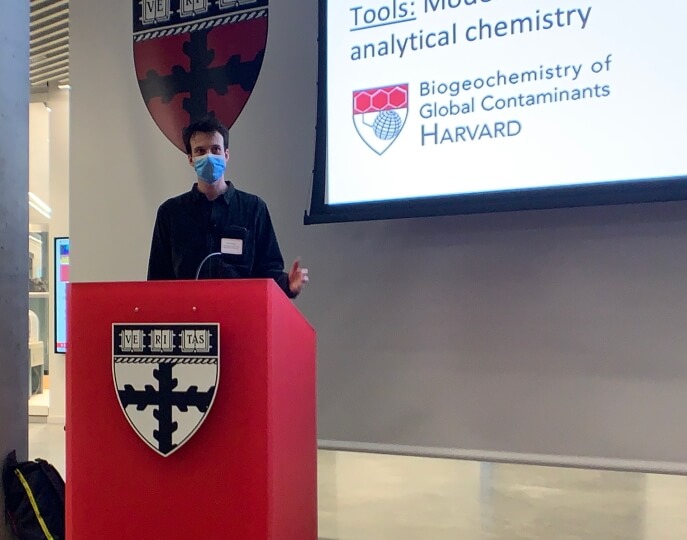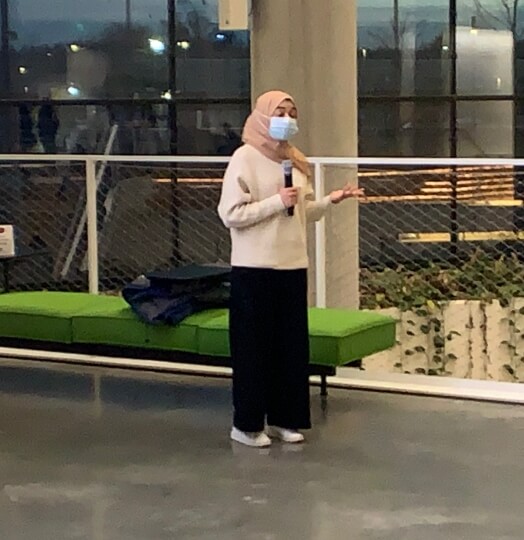News
No engineering education is complete without the lab. Laboratory research puts a student’s coursework into practice, and the right lab can unlock scientific interests a student might never have even considered.
There’s a lab for every student at the Harvard John A. Paulson School of Engineering and Applied Sciences (SEAS), whatever their concentration.
“The engagement in undergraduate research is so exciting and so innervating for delivering new ideas,” said Dean Frank Doyle. “The richness of the intellectual endeavors going on throughout SEAS and the sciences is really something you have to have an opportunity to experience.”
Ph.D. student Ben Geyman presents at the SEAS Research Showcase on March 8 in the Science & Engineering Complex atrium. (Credit: Matt Goisman/SEAS)
The variety of available research opportunities was the central message of the inaugural SEAS Research Showcase on March 8 in the Science & Engineering Complex atrium.
The event was organized by the Task Force for Strategic Inclusion in Undergraduate Research, headed by Jim Anderson, the Philip S. Weld Professor of Atmospheric Chemistry at SEAS.
Frank Keutch, the Stonington Professor of Engineering and Atmospheric Science at SEAS and Professor of Chemistry and Chemical Biology, opened the presentations with his research into the effect of stratospheric aerosol on the climate.
“In a lot of coursework, there’s a known recipe to solve it,” said Keutch. “When you work in a lab, you’re working on a problem that nobody knows the answer to, and that’s a very different framework of problem solving. It really drives you towards independent problem solving, which in life is what you really need.”
Fourteen SEAS graduate students gave three-minute presentations on current research happening in their labs. Topics ranged from the technologies inspired by the natural world being designed in the Aizenberg Biomineralization and Biomimetics Lab, to research into machine learning as it relates to adversarial internet activity happening at the Institute for Applied Computational Science, to efforts to develop smarter power grids in the lab of Na Li, the Gordon McKay Professor of Electrical Engineering and Applied Mathematics.
“In our lab, we strive to understand nature,” said Athena Economides, a postdoctoral researcher in the Computational Science & Engineering Laboratory. “We do this by using models, algorithms, data and, of course, computers.”
Missed the showcase? Here’s the full list of everyone who presented at the SEAS Research Showcase.
- “Role of organic aerosol in the atmosphere: climate and ozone” – Frank Keutch, Keutch Research Group
- "Bioinspired materials: novel material behavior through molecular design" – Milan Wilbom, Aizenberg Biomineralization and Biomimetics Lab
- “CRISP Lab: Computation, Representations and Inference in Signal Processing” – Alex Lin, Computation, Representation, and Inference in Signal Processing Group
- “Robustness to adversarial attack in natural language processing” – Jack Scudder, Institute for Applied Computational Science
- “What GPT knows about who is who” – Xiaohan Yang, IACS
- “Solar geoengineering” – Ansar Lemon, David Keith Research Group
- “Research in the CSElab: AI & computing” – Athena Economides, Computational Science & Engineering Laboratory
- “Transforming nanotechnologies in next generation computing systems” – Georgios Kyriazidis, Nano-Design Group
- “Machine learning for biomedical analysis” – Junsik Kim, Visual Computing Group
- “Linking forests, chemistry and air pollution” – Josh Cox, Keutch Research Group
- “Your computer should have unlimited memory: far memory research” – Yang Zhou, Minlan Yu and James Mickens Labs
- “Developing environmentally sustainable electronics” – Mariam Elgamal, Nano-Design Research Group
- “The future of smart energy systems” – Xin Chen, Na Li Lab
- “A tiny part of the work of the Berkman Klein Center” – Justin Clark, Berkman Klein Center for Internet & Society
- “Addressing the impacts of the global chemical experiment” – Ben Geyman, Biochemistry of Global Contaminants Research Group
For environmental engineering concentrators, Josh Cox, a Ph.D. student in Keuth’s lab, presented on the links between forests, chemistry, and air pollution.
Ansar Lemon, a Ph.D. student in the research group of David Keith, the Gordon McKay Professor of Applied Physics, presented on solar geoengineering.
“Solar geoengineering is an umbrella term describing a variety of methods for reflecting a portion of incoming sunlight towards the earth to account for global warming and greenhouse effects,” said Lemon. “The approach that we’re studying is using sulfate-based aerosols in the stratosphere, an idea inspired by volcanic eruptions. There are several studies showing there is a strong cooling effect in the event of a volcanic eruption, so what if you were to try to replicate this on a global scale?”
Ph.D. student Mariam Elgamal presents at the SEAS Research Showcase on March 8 in the Science & Engineering Complex atrium. (Credit: Matt Goisman/SEAS)
Electrical engineering research presenters included Mariam Elgamal, a Ph.D. student in the Nano-Design Research Group working on environmentally sustainable electronics.
“For me, lab work was really interesting because I did research in material science and artificial neural networks,” Elgamal said. “I was able to dabble in completely different areas from just electrical engineering and computer science, which is what I majored in in undergrad. It was very, very critical to understand what research path I wanted.”
Every seat was filled for the approximately 45-minute showcase, with many more students standing along the nearby atrium walls. Students were then given the chance to talk face-to-face with the researchers, with at least a couple undergraduates speaking to each lab’s representative.
“If I didn’t do research, I wouldn’t have applied to graduate school,” Cox said. “It gave me another perspective on my classes, because I could relate the two and see my classwork in practice in the research environment.”
Cox and Elgamal both said lab work has been a critical part of their academic success and advancement.
By organizing the school’s first research showcase, the Task Force for Strategic Inclusion in Undergraduate Research hopes to inspire current undergraduates to pursue those same paths.
“There are many research endeavors going on at SEAS and in the science departments that have a fundamental richness to them,” Anderson said. “We saw a tiny fraction of what is available tonight.”
Cutting-edge science delivered direct to your inbox.
Join the Harvard SEAS mailing list.
Press Contact
Matt Goisman | mgoisman@g.harvard.edu




